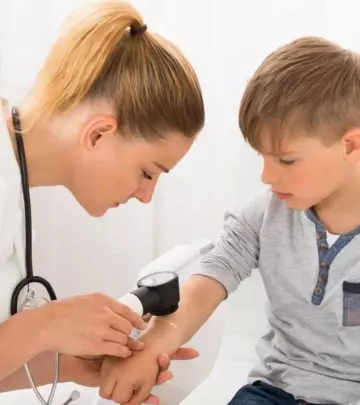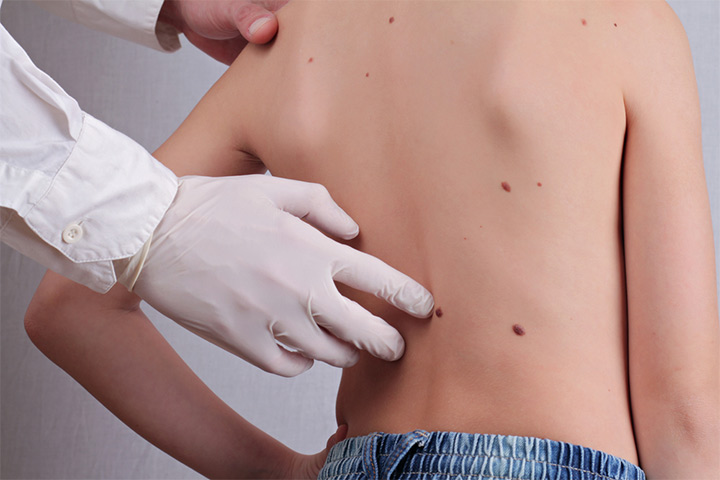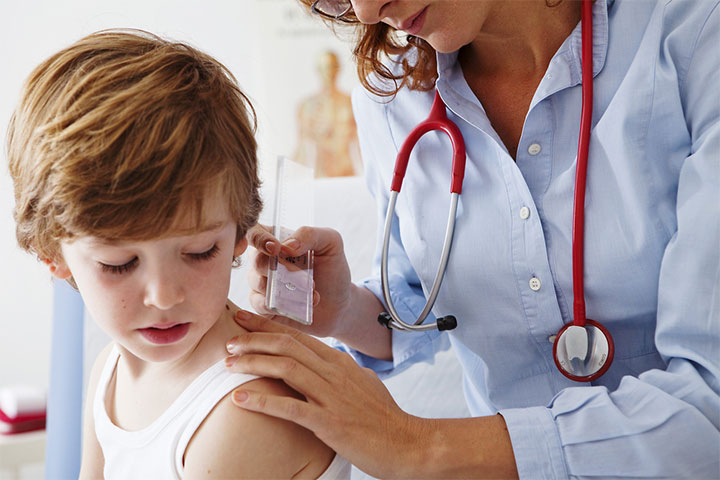
Image: Shutterstock
Moles are common in humans, including kids and adults. Even you might have a few on different parts of your body. Some moles may be present since birth whereas others may appear at a later stage of your life due to various reasons. A mole may not always raise a red flag, but if it changes its color, size, or shape, it might be worth looking into. Before we delve into the topic of melanoma, let’s take a look at the different types of moles found in kids.
Types Of Moles
The 4 different types of moles are as follows (1):
Congenital nevi:Congenital moles are those that are present in the body since birth.
Dysplastic nevi:Also known as atypical moles, they vary in color and size. They change in size and may have irregular edges and uneven surfaces. Congenital nevi and dysplastic nevi are the two types of moles that are most likely to turn into melanoma when compared to the other moles.
Acquired nevi:Just like the name suggests, acquired moles are moles that a person acquires later in life and will not be present during birth. Such moles may appear due to excess sun exposure, hormonal, or other changes. An acquired mole can also be a dysplastic nevus.
Spitz nevus: Spitz nevus typically resembles cancerous moles and require a biopsy to identify. They may also leak pus or bleed.
Identifying Unusual Moles That May Carry Cancer Risks
Often melanoma starts out as a simple mole on the skin, which makes it important to figure out if a mole has changed its color, size, or shape. This ABCDE guide will help you understand if a mole needs to be checked out by your child’s doctor or dermatologist (2).
- A For Asymmetry
Is the left half of the mole the same as the other half? If the mole is asymmetrical, it may be an indication of melanoma.
- B For Border
Check the border of the mole. Is it blurry, irregular, or undefined? Cancerous moles may not have smooth borders.
- C For Color
Does the mole appear uneven in color? If a mole looks lighter or darker in certain areas or has a different color in one of the spots, it may be wise to get it checked out.
- D For Diameter
Does the mole appear to be bigger than a pencil top eraser? If a mole seems larger than 6 millimeters (¼ inch), it may be cancerous.
- E For Evolving
If a mole is evolving either in terms of color, shape, size, or elevation, it might be best to get it checked out. It is also important to watch for any new signs or symptoms such as bleeding or itchiness.
Risk Factors
A person may be diagnosed with melanoma even if they do not fall into any of the following categories and can be at risk if they have a family history of the same. However, the below factors increases the risk of the disease (3):
- Has a large number of moles, typically greater than 25
- Green or blue eyes
- Red or blonde hair
- Excessive UV exposure from the sun or tanning bed
- History of frequent sunburns
- Fair complexion
- Older age groups
Treatment Plans
If a mole appears to be of cancerous nature, a doctor may do any of the following procedures based on the nature and type of mole (4):
- Immunotherapy is done to boost the body’s immune system to fight against cancerous cells.
- Targeted therapy is done by giving medications to fight cancer cells without harming other cells.
- Chemotherapy is another procedure that is done to kill cancerous cells. It is done either intravenously, through the mouth, or by injection.
- Surgery may also be opted to remove the lesion or mole from the skin.
If a mole on your child’s body appears to be of cancerous nature, it is important to get it checked by a doctor to help diagnose and start the treatment right away. You can also teach your child to monitor any abnormal growths or moles on their skin by following the ABCDE guide mentioned above. Parents can also advise their kids to limit their exposure to UV rays by applying sunscreen, wearing the right kind of clothes and hats, and abstaining from tanning salons.
















